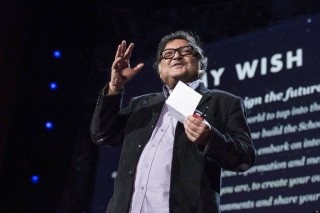A beginner’s guide to Professor Sugata Mitra
Best known for:
In 1999 Mitra carried out a series of Hole in the Wall (HIW) experiments about children's learning. The first experiment involved children being given free access to a computer embedded in a wall between his office and a Delhi slum. The experiment aimed to prove that children could easily learn from computers without any formal training, a phenomenon Mitra called Minimally Invasive Education.
The experiment demonstrated that children could learn to use computers and the Internet on their own in open spaces such as roads and playgrounds, even without knowing English. In 2013, Mitra's TED Talk Build a School in the Cloud discussed the Hole in the Wall experiment. His write-up of the experiment was judged the best open access publication in the world in 2005 and he was also awarded the Dewang Mehta Award for innovation in IT that year.
Quick biography:
Where does he work?
Mitra is currently Professor of Educational Technology at the School of Education, Communication and Language Sciences at Newcastle University. His current research builds on his 'Hole in the Wall' experiment, which Mitra instigated in 1999 while chief scientist at NIIT, an Indian Multinational company. In 2013, he was awarded the $1m TED Prize in recognition of his work and to help build a School in the Cloud; a creative online space where children from all over the world can gather to answer 'big questions', share knowledge and benefit from online teachers. He earned his PhD in 1978 from the Indian Institute of Technology.
What's it all about:
What does he research?
Mitra's first research interests involved computer networking. He set up India's first local area network based newspaper publishing system in 1984 and went on to predict the desktop publishing industry. His interest in electronic networks – combined with his interest in the human mind – led him to explore how people learn. This has in turn propelled his research and activities in 'Self Organised Learning Environments (Soles)', such as the School in the Cloud.
What he says:
"If a group of children find a question they think is important, they will search for an answer. On the Internet, this will usually result in finding good information. Groups of children, in the presence of good information will discuss possible answers. Most of the time, such a process results in the emergence of good answers. A by-product of this process is learning."
What others say:
Why you should consider reading more:
As well as working with schools in West Bengal, New Delhi and Maharashtra, Mitra has worked with George Stephenson High School in Killingworth, North Tyneside and Greenfield Community College in Newton Aycliffe, County Durham.
This year, 40 schools in the North East of England started using Mitra's Soles. At one primary school in Gateshead, Year 4 pupils using the Sole techniques were able to answer GCSE physics and biology questions confidently. Although Mitra is in the early stages of building up an empirical justification for his methods, they are gaining traction and may interest educators keen to introduce more computer-based learning to their pupils.
Top reads:
Build a School in the Cloud (TEDTalk, 2013)
How to Bring Self-Organised Learning Environments to Your Community (2013)
Further information:
EdProfessional members:
Use this link to directly access summaries, links and reviews about Professor Mitra's Hole in the wall project.
Related Posts
Comments
By accepting you will be accessing a service provided by a third-party external to https://edcentral.uk/


